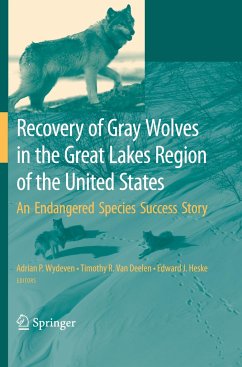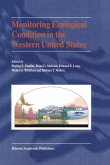The Great Lakes region is unique in that it is the only portion of the lower 48 states where wolves were never extirpated. As the birthplace of some of the first modern concepts of wolf conservation and research, the region is also the first place in the U.S. where "endangered" wolf populations recovered.
During this process, much has been learned about wolf biology and ecology, endangered species management, carnivore conservation, landscape ecology, depredation management, and social aspects of wildlife conservation. Recovery of Gray Wolves in the Great Lakes Region of the United States traces wolf recovery in this region and highlights lessons learned by conservationists during the recovery process. Each chapter includes a thorough review of the pertinent literature, in addition to new data and new perspectives and interpretations. The result is both rigorous with respect to science and policy and accessible and interesting for the lay reader. The story of wolf recovery in the Great Lakes region is one of international significance for conservationists.
In this book, we document and evaluate the recovery of gray wolves (Canis lupus) in the Great Lakes region of the United States. The Great Lakes region is unique in that it was the only portion of the lower 48 states where wolves were never c- pletely extirpated. This region also contains the area where many of the first m- ern concepts of wolf conservation and research where developed. Early proponents of wolf conservation such as Aldo Leopold, Sigurd Olson, and Durward Allen lived and worked in the region. The longest ongoing research on wolf-prey relations (see Vucetich and Peterson, Chap. 3) and the first use of radio telemetry for studying wolves (see Mech, Chap. 2) occurred in the Great Lakes region. The Great Lakes region is the first place in the United States where "Endangered" wolf populations recovered. All three states (Minnesota, Wisconsin, and Michigan) developed ecologically and socially sound wolf conservation plans, and the federal government delisted the population of wolves in these states from the United States list of endangered and threatened species on March 12, 2007 (see Refsnider, Chap. 21). Wolf management reverted to the individual states at that time. Although this delisting has since been challenged, we believe that biological recovery of wolves has occurred and anticipate the delisting will be restored. This will be the first case of wolf conservation reverting from the federal government to the state conser- tion agencies in the United States.
During this process, much has been learned about wolf biology and ecology, endangered species management, carnivore conservation, landscape ecology, depredation management, and social aspects of wildlife conservation. Recovery of Gray Wolves in the Great Lakes Region of the United States traces wolf recovery in this region and highlights lessons learned by conservationists during the recovery process. Each chapter includes a thorough review of the pertinent literature, in addition to new data and new perspectives and interpretations. The result is both rigorous with respect to science and policy and accessible and interesting for the lay reader. The story of wolf recovery in the Great Lakes region is one of international significance for conservationists.
In this book, we document and evaluate the recovery of gray wolves (Canis lupus) in the Great Lakes region of the United States. The Great Lakes region is unique in that it was the only portion of the lower 48 states where wolves were never c- pletely extirpated. This region also contains the area where many of the first m- ern concepts of wolf conservation and research where developed. Early proponents of wolf conservation such as Aldo Leopold, Sigurd Olson, and Durward Allen lived and worked in the region. The longest ongoing research on wolf-prey relations (see Vucetich and Peterson, Chap. 3) and the first use of radio telemetry for studying wolves (see Mech, Chap. 2) occurred in the Great Lakes region. The Great Lakes region is the first place in the United States where "Endangered" wolf populations recovered. All three states (Minnesota, Wisconsin, and Michigan) developed ecologically and socially sound wolf conservation plans, and the federal government delisted the population of wolves in these states from the United States list of endangered and threatened species on March 12, 2007 (see Refsnider, Chap. 21). Wolf management reverted to the individual states at that time. Although this delisting has since been challenged, we believe that biological recovery of wolves has occurred and anticipate the delisting will be restored. This will be the first case of wolf conservation reverting from the federal government to the state conser- tion agencies in the United States.
From the reviews:
"This book documents and evaluates the recovery of the gray wolf in the Great Lakes Region, where modern concepts of wolf conservation developed. Twenty-three chapters written by numerous wolf biologists cover all aspects of the recovery effort, starting with early history, research, and conservation in this area. ... This book provides a model for future recovery efforts and the management of wolf populations, as well as of large predators. Summing Up: Recommended. All general, academic, and professional audiences." (R. L. Smith, Choice, Vol. 47 (2), October, 2009)
"Each chapter reads like a scientific paper that addresses its topic with scholarly thoroughness. ... The chapters are essentially research papers written by scientists for other scientists. Anyone who can read a newspaper can understand most of this material ... . In short, this book is a serious attempt to understand a major topic in wolf restoration. This compilation of scholarship is likely to be the most authoritative and carefully researched book on the topic for a long time to come." (Steve Grooms, International Wolf, Spring, 2010)
"This book documents and evaluates the recovery of the gray wolf in the Great Lakes Region, where modern concepts of wolf conservation developed. Twenty-three chapters written by numerous wolf biologists cover all aspects of the recovery effort, starting with early history, research, and conservation in this area. ... This book provides a model for future recovery efforts and the management of wolf populations, as well as of large predators. Summing Up: Recommended. All general, academic, and professional audiences." (R. L. Smith, Choice, Vol. 47 (2), October, 2009)
"Each chapter reads like a scientific paper that addresses its topic with scholarly thoroughness. ... The chapters are essentially research papers written by scientists for other scientists. Anyone who can read a newspaper can understand most of this material ... . In short, this book is a serious attempt to understand a major topic in wolf restoration. This compilation of scholarship is likely to be the most authoritative and carefully researched book on the topic for a long time to come." (Steve Grooms, International Wolf, Spring, 2010)








